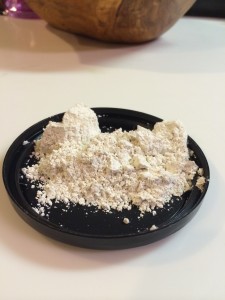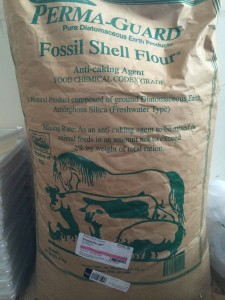8 Practical Uses for Diatomaceous Earth
Diatomaceous Earth (DE), what is it good for, absolutely everything! Well, maybe not everything… I don’t think I will be using it to clean anything anytime soon as it creates more dust than a whirling dervish (I’m just assuming they kick up some dust).
I recently received a message from a friend asking, “Wanted to know if you have every used Diatomaceous Earth or knew anything about it?” Yup, I do know about DE as we have been using it here on the farm for several years.
This wonderful substance that we lovingly refer to as DE (because few, including me, can pronounce it’s full name consistently correctly) is widely used all over the world for a multitude of things. Here on The Shepherd Hobby Farm we use it as an animal feed additive, garden pest control, carpet duster and external parasite control (a lot like a topical flea/mite powder).
DE comes from fossilized diatoms (algae) that have calcified and layered as sedimentary rock. In the United States, it is now mined from old lake beds which are mainly in Colorado and Nevada. It feels like a very light powder because each diatom is so porous, but they each have jagged edges. These properties are key to its functions (according to Mother Earth News).
I’ve heard people give two different explanations of how DE works. Many say it works in both of these ways.
One is that on a microscopic level, the diatomaceous earth particles are very sharp looking. These particles stick to an insect and get stuck between its exoskeleton joints. As the insect moves, it gets physically cut up.
The other explanation is that diatomaceous earth sticks to the insect and somehow causes them to dry out. I think this approach involves scratching the insects waxy layer which then allows precious moisture within the insect to get out. So their teeny tiny bug-innards turn into teeny tiny bug-innards-jerky.
Unless you’re buying filters for a swimming pool, the DE you want must be “food grade.” This won’t be contaminated with anything toxic and won’t be dangerous to breathe or handle. You can buy the food grade DE at your local feed store, some nurseries and online. One brand for smaller quantities is called “Pure-Earth.” Our 50# bags are called, “Perma-Guard.”
Below I will list all the ways I know of that it can be used and the pluses and minuses of each use.
- Worming medicine: We have goats, sheep, horses, dogs, cats, chickens, guineas, and rabbits here on The Shepherd Hobby Farm. Most of those animals (except for dogs, cats, and rabbits) are notorious for carrying worm loads on an ordinary day to day basis. We do fecal counts often to ensure our animals are within healthy ranges and keep them this way with the use of some chemical wormers when the need arises. However, our preventative program including herbs, minerals, and DE has provided us with a program in which our animals stay extrememly healthy using these natural ingredients. We mix DE into the horse, sheep, chicken, and goat feed each morning and evening. The concept behind this is that the DE travels through the animals system and the sharp edges of the DE do nothing to the animal (because they are so small) but wedge into the exoskeletons of the parasites and kill them.
- Fly control. If you have horses (or cows, llamas, alpacas… hooved creatures that poop a lot) then you understand when I say I really dislike flies. The concept here is, “what goes in must come out.” The DE goes in through them eating their feed and also comes out when they poo. It’s there in it’s ever wonderful glory when flies come sand lay their eggs in the piles of poo. When the eggs hatch out in to little maggots the DE once again wedges itself in and around, tears them all up, and dehydrates them. This has drastically reduced our fly population the last few years. Sometimes I also sprinkle some DE on fresh piles I see flies swarming around just in case.
- Insecticide in the garden: We do not use any chemical pesticides, herbicides, or insecticides here at the farm. At one point our chickens were loose to free range the entire property (including our front pirch which is why we have changed things a bit as far as chickens go) and therefore we chose not to use any chemicals that may make its wasy into our chickens and eggs. DE is thought to work externally on crawling insects by scratching the exoskeleton, absorbing protective lipids and causing them to dehydrate. Studies show that it is not harful to bees or earthworms (though I am a little dubious as I don’t know how it would affect maggots in a horse manure pile but not an earthworm… something seems a little off. I use DE sparingly in the garden and only when the infestation of unwanted critters is more than I can handle with handpicking and other pest control practices.
- Carpet duster. We have four dogs and ten cats. Three of the four dogs are inside the majority of the time and many of the cats try to sneak in he house at every given opportunity. Therefore, even though they are all on flea and tick preventative it doesn’t mean some of these little icky pest won’t hitchike in on one of them to try to make a meal out of one of use. Therefore, once a week I dust my carpets with a mixture of baking soda, DE, and cedarwood essential oil. I let sit for a few hours (sometime sovernight) and vacuum up. This not only kills any pests in my carpets but also freshens and deodorizes it!
- Pest control on the skin of animals: As I mentioned before, all ou dogs and cats are on a chemical flea prevention but we choose a more organic and natural route for tick and mites (chickens). We comb through our dogs and cats each day for ticks and dust the goats, sheep, and chickens with DE once a week. I sprinkle it onto their coats and rub it in while making them completely happy with a little rub down. They LOVE this one on one time!
- Hydroponic: DE is like perlite or vermiculite and retains water and nutrients in the soil. Its porosity means that the soil will also drain well. This makes it great for potted plants.
- Feed bags: With some of the animal’s feed bags that are particularly susceptible to insects and pests I put a cup of DE in and mix it all up so they die, die, die and stop eating my anima’s feed!
- Human detox: I have not done this but have heard about it being done… Many people eat a quarter cup of food grade diatomaceous earth every day. They mix it into juice. I have visited with several people that are keen on living past 100 years that believe that eating lots diatomaceous earth every day will help them with that goal. I have found references where it is cited for colon cleansing, parasite control and detox. Not really interested myself, but just thought I’d throw that out there.
Earthworks Health has an interesting list of uses and claims for DE (human use). Check it out if you are interested in seeing what all DE could do for your body.
Well folks, that’s what I’ve got for DE. Thanks for the questio Karis and feel free to ask any follow-up questions or let me know what your plans ar with DE. Anyone else have ideas for DE?
Happy Day All!
Jhenna

 Follow
Follow
